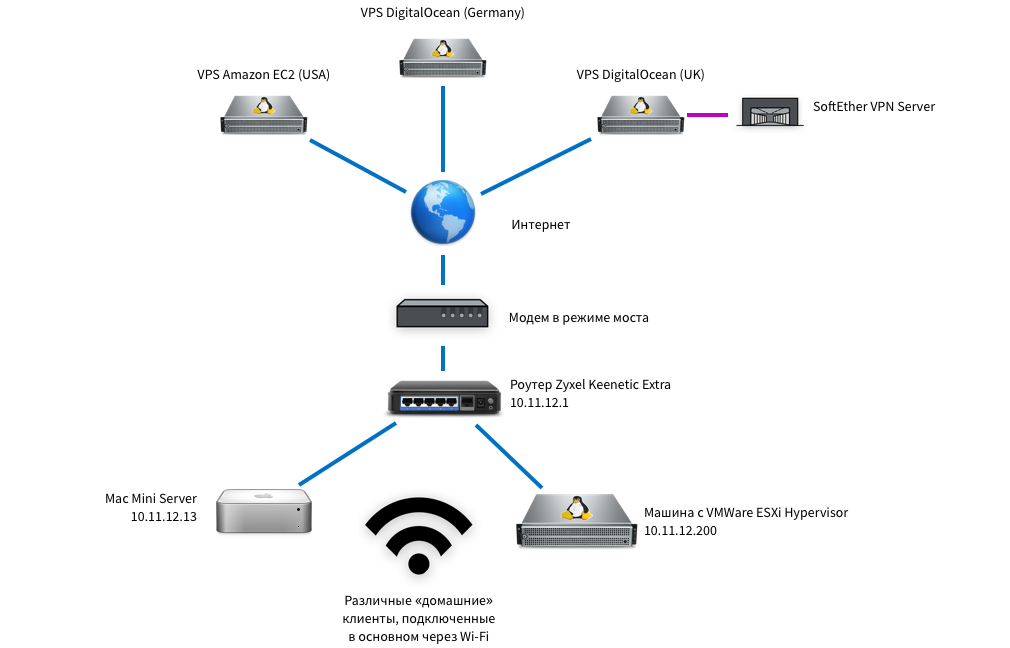Answer the question
In order to leave comments, you need to log in
How to combine home machines and remote servers into one network?
Hello!
There is a question with which I have been racking my brains for more than one week, while I understand that the answer is somewhere on the surface, but I’m not smart enough to come up with the right query in Google.
There is approximately such a network: 
Everything below the element with the Earth (this is like the Internet in the global sense) is a home network. Everything above is VPS from different providers in different parts of the world, as well as a couple of ordinary working servers running Ubuntu with "white" addresses.
The home network begins with a Rostelecom modem (a certain Arris CM820), which operates in bridge-mode and has a Zyxel Keenetic Extra router plugged into its only ethernet port, which raises a PPPoE connection to access the Internet.
I’ll make a reservation right away that it’s a no brainer: this is the mechanics of connecting to the Internet - this is the 19th century as it is, but the problem is that my house was just built in the 19th century and since then not a single provider , except for Rostelecom, did not dare to connect our poor 8 apartments to its network. A coaxial cable is plugged into the modem itself and goes somewhere out the door. The connection is made using DOCSYS 3.0 technology - as far as I understand, this is some kind of ADSL follower or something like that. But that's not the point.
A static IP address was bought from Rostelecom, which is perfectly listened to from the outside.
On the router (10.11.12.1), DHCP (10.11.12.20-60), NAT is running, ports are forwarded where necessary.
There are two machines plugged into the router with a cable and always working: one is a Mac Mini on OS X Server 10.11 - almost a pointless device, considering what Apple has turned the server axis into in recent years (spoiler: nothing). Backups are written to it, a time machine, torrents are downloaded and, in general, it is high time to turn it off and put it on the far shelf - it only eats electricity, and backups and torrents can be implemented differently.
The second is a fairly powerful computer by home standards, on which the VMWare ESXi 5.1 hypervisor is installed and virtual machines are spinning for their own (mainly educational) needs.
There are also “free” (in the sense, unused) pair of laptops and a system unit, which, if anything, can be used as a server / router, however, I still don’t quite understand how and whether it is necessary at all.
Based on the foregoing, I have two questions for the highly respected community:
1. How to connect all this into one virtual network? VPN, VLAN, EoIP, tunneling - these are the words I picked up, more or less got to the point and now I want to understand how to do it right so that it all turns into a single virtual network consisting of a physically existing home network and an indefinite number of remote machines. That is, ideally, in my home network 10.11.12.x, all overseas VPSs and other machines that are physically located somewhere very far away should appear. If the best option is a VPN, then how best to organize it? Where should the server be installed?
2. Can a machine with one physical network interface act as a router? If yes, how to implement it? I have been dangling in my head for a long time the idea of replacing the Zyxel Keenetic router with a switch + a machine running Ubuntu or some kind of "router" OS, but, again, I'm not sure about the correctness of this decision if there is, in general, not the worst (for home needs) of the router.
Thanks in advance to everyone for your help! :)
Answer the question
In order to leave comments, you need to log in
A machine with one physical router interface can work - if you configure the VLAN, and thus get an infinite number of logical interfaces.
To implement your idea, you need to: -
throw VPN tunnels to the router from all VPS
- set the correct addressing
For example
10.0.1.1/30 - первая VPS, у роутера адрес 10.0.1.2/30
10.0.2.1/30 - вторая VPS, у роутера адрес 10.0.2.2/30
10.0.3.1/30 - третья VPS, у роутера адрес 10.0.3.2/30
...
Домашние машины рассадить в сеть
10.1.0.0/16If you are not too lazy to place clients everywhere, then OpenVPN will work quite well . You won't need to change anything in the hardware, and in the network diagram. Just another virtual network interface will be automatically added to this network and organize a lan.
Server - somewhere in any virtual machine, the rest - clients. Install once and forget.
Didn't find what you were looking for?
Ask your questionAsk a Question
731 491 924 answers to any question